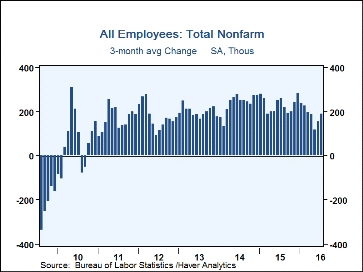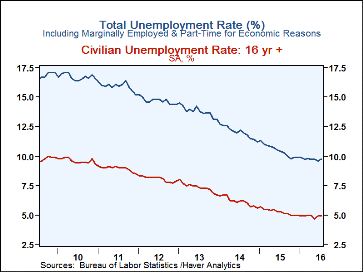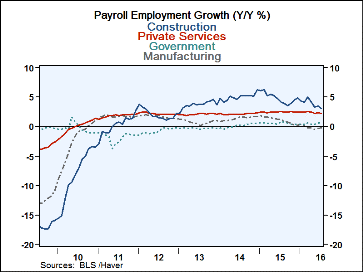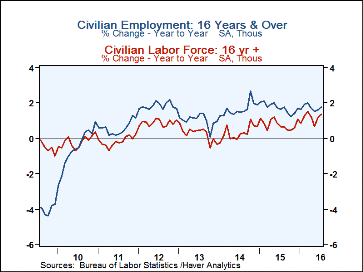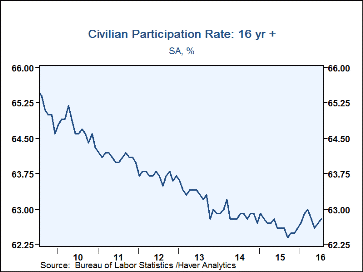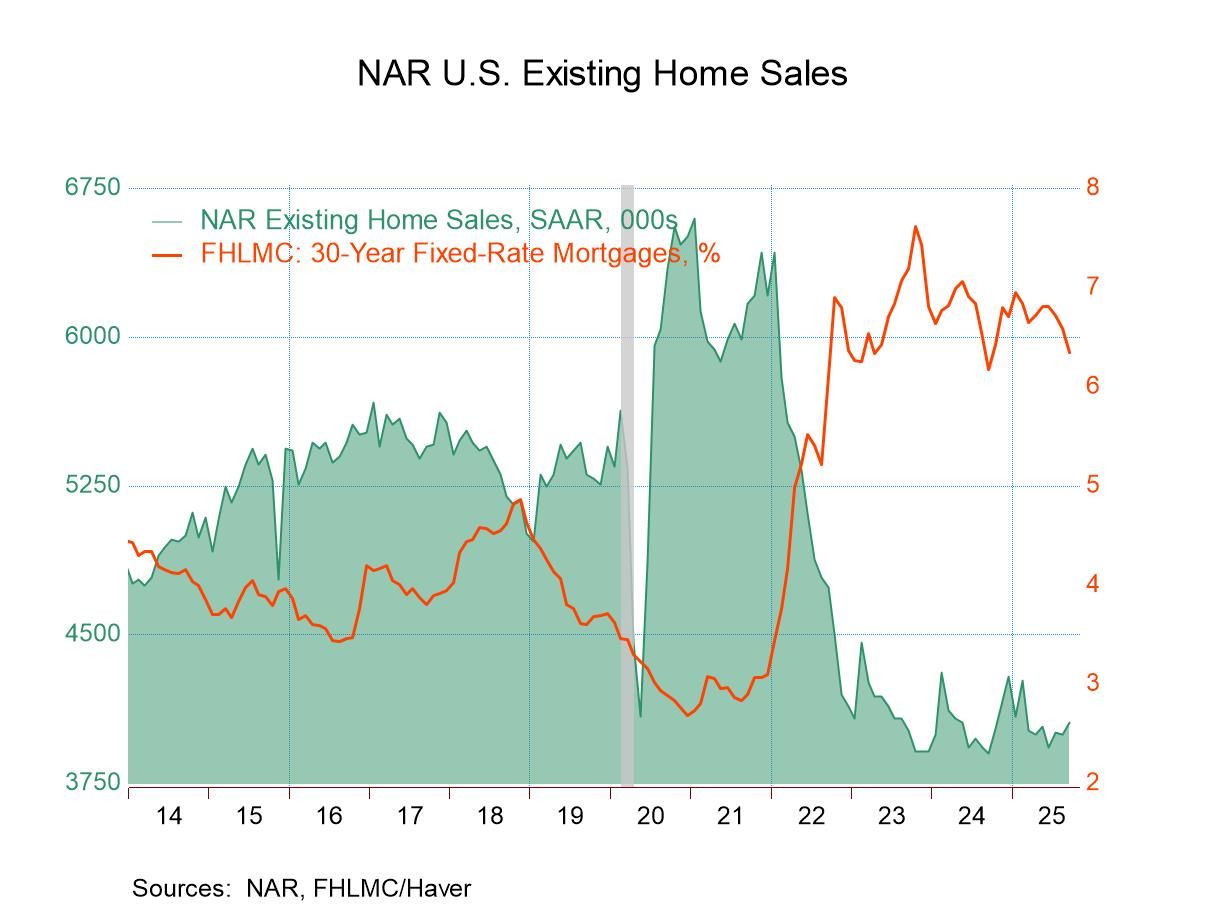 Global| Aug 05 2016
Global| Aug 05 2016U.S. Payroll Growth Is Surprisingly Strong
by:Tom Moeller
|in:Economy in Brief
Summary
The job market remained on firm footing during July. Nonfarm payroll employment grew 255,000 (1.7% y/y) following upwardly revised gains of 292,000 and 24,000 during the prior two months. A 180,000 increase had been expected in the [...]
The job market remained on firm footing during July. Nonfarm payroll employment grew 255,000 (1.7% y/y) following upwardly revised gains of 292,000 and 24,000 during the prior two months. A 180,000 increase had been expected in the Action Economics Forecast Survey. The three-month average change in payrolls of 190,000 was the strongest since March, but was below the peak 259,000 three-month change averaged last July. The unemployment rate remained at 4.9%. A 4.8% rate was expected. The unemployment rate including marginally attached workers and those working part-time for economic reasons ticked up to 9.7%. Average hourly earnings gained 0.3% (2.6% y/y) versus expectations for a 0.2% rise.
Payroll employment improvement was broad-based. It included a 14,000 rise (3.3% y/y) in construction employment which followed three straight months of decline. Factory sector employment increased 9,000 (-0.3% y/y), though that was below June's 15,000 increase. Mining sector employment declined 6,100 (-16.8% y/y), moderate versus the 17,600 jobs lost in February.
In the private service-producing sector, payrolls increased 201,000 (2.2% y/y) following a 254,000 increase. Three-month average growth of 166,000 was improved versus the prior two months, but well below December's cycle high of 238,000. Professional & business services employment grew 70,000 (2.6% y/y), the firmest gain in nine months. The increase included a 17,000 rise (0.9% y/y) in temporary help jobs. Employment in leisure & hospitality grew 45,000 (2.7% y/y) after a similarly strong 52,000 June rise. The two gains together were at the high end of increases averaged during the recovery. Education & health services employment improved 36,000 (2.8% y/y), the weakest gain in six months. Trade, transportation & utilities employment improved 29,000 (1.4% y/y), though retail jobs rose just 14,700 (1.9% y/y), well off the 66,500 pace six months earlier. Employment in financial activities improved 18,000 (2.0% y/y), one of the stronger gains this cycle. Information sector employment remained unchanged (1.1% y/y). Government sector payrolls increased 28,000 (0.7% y/y) as local government jobs rose 30,000 (0.8% y/y). State government jobs increased 5,000 (0.5% y/y) and federal government employment rose 3,000 (1.2% y/y).
The length of the average workweek improved to 34.5 hours, up from 34.4 hours in each of the prior five months. It remained down, however, from the 34.6 hour peak for this cycle. Hours worked in the goods producing sector was steady at 40.3 hours, but down from the 2014 peak of 40.6 hours. Private service sector hours were steady at 33.3. Within that total, however, there were sharp divergences. Hours worked in financial activities returned to the cycle peak of 37.7, while hours in the information sector of 36.1 were down from the 2014 high of 36.9 hours. Time worked in the leisure & hospitality sector eased to 26.1 hours.
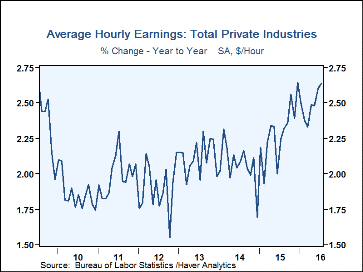 The 0.3% gain in average hourly earnings was the strongest rise in three
months. It raised y/y growth to 2.6% which equaled the strongest increase for
this cycle, and was up from 1.9% during all of 2012. Earnings in service
industries improved 0.3% (2.6% y/y), paced by a 1.0% increase (3.0% y/y) amongst
financial activities. Leisure & hospitality earnings rose 0.4%, but y/y
growth jumped to 4.0%, the largest increase since 4.6% early in 2008. This
strength was offset by a 0.1% rise (2.5% y/y) in trade, transportation &
utilities which included a 0.3% decline (+2.1% y/y) in retail trade.
The 0.3% gain in average hourly earnings was the strongest rise in three
months. It raised y/y growth to 2.6% which equaled the strongest increase for
this cycle, and was up from 1.9% during all of 2012. Earnings in service
industries improved 0.3% (2.6% y/y), paced by a 1.0% increase (3.0% y/y) amongst
financial activities. Leisure & hospitality earnings rose 0.4%, but y/y
growth jumped to 4.0%, the largest increase since 4.6% early in 2008. This
strength was offset by a 0.1% rise (2.5% y/y) in trade, transportation &
utilities which included a 0.3% decline (+2.1% y/y) in retail trade.
The household survey revealed a stable 4.9% unemployment rate which reflected a 420,000 rise (1.8% y/y) in employment and a 407,000 (1.4% y/y) increase in the labor force. The labor force participation rate improved to 62.8% versus the cycle low of 62.4% in September, but remained well below the 67.1% averaged from 1997 to 2000.
The teenage unemployment rate eased to 15.6%, its low for the economic recovery. For those aged 25 and over, the rate was stable at 4.0%; for individuals aged 35-44, it fell to 3.5%.
By educational attainment, the unemployment rate for those with less than a high school diploma fell sharply to a cycle low of 6.3%. High school graduates with no college encountered a stable 5.0% unemployment rate, while those with some college but no degree were 4.3% unemployed. College graduates met with the lowest unemployment rate at 2.5%.
The labor market data are contained in Haver's USECON database. Detailed figures are in the EMPL and LABOR databases. The expectations figure is in the AS1REPNA database.
| Employment: (SA, M/M Change, 000s) | Jul | Jun | May | Jul Y/Y | 2015 | 2014 | 2013 |
|---|---|---|---|---|---|---|---|
| Payroll Employment | 255 | 292 | 24 | 1.7 | 2.1% | 1.9% | 1.6% |
| Previous | -- | 287 | 11 | -- | -- | -- | -- |
| Manufacturing | 9 | 15 | -17 | -0.3 | 1.1 | 1.4 | 0.8 |
| Construction | 14 | -3 | -18 | 3.3 | 4.8 | 5.0 | 3.7 |
| Private Service-Producing | 201 | 254 | 44 | 2.2 | 2.5 | 2.1 | 2.1 |
| Government | 38 | 33 | 25 | 0.7 | 0.5 | 0.0 | -0.3 |
| Average Weekly Hours - Private Sector | 34.5 | 34.4 | 34.4 | 34.6 | 34.5 | 34.5 | 34.5 |
| Private Sector Average Hourly Earnings (%) | 0.3 | 0.1 | 0.2 | 2.6 | 2.3 | 2.1 | 2.1 |
| Unemployment Rate (%) | 4.9 | 4.9 | 4.7 | 5.3 | 5.3 | 6.2 | 7.4 |
Tom Moeller
AuthorMore in Author Profile »Prior to joining Haver Analytics in 2000, Mr. Moeller worked as the Economist at Chancellor Capital Management from 1985 to 1999. There, he developed comprehensive economic forecasts and interpreted economic data for equity and fixed income portfolio managers. Also at Chancellor, Mr. Moeller worked as an equity analyst and was responsible for researching and rating companies in the economically sensitive automobile and housing industries for investment in Chancellor’s equity portfolio. Prior to joining Chancellor, Mr. Moeller was an Economist at Citibank from 1979 to 1984. He also analyzed pricing behavior in the metals industry for the Council on Wage and Price Stability in Washington, D.C. In 1999, Mr. Moeller received the award for most accurate forecast from the Forecasters' Club of New York. From 1990 to 1992 he was President of the New York Association for Business Economists. Mr. Moeller earned an M.B.A. in Finance from Fordham University, where he graduated in 1987. He holds a Bachelor of Arts in Economics from George Washington University.


